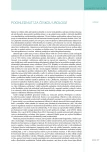Late secondary bleeding after percutaneus nephrolithotomy
Authors:
Zdeněk Peremský 1; Filip Cihlář 2; Jiří Král 1; Miloš Bočan 1; Milouš Derner 2
Authors‘ workplace:
Urologické oddělení Nemocnice Most o. z., Krajská zdravotní a. s.
1; Radiodiagnostické oddělení Masarykovy Nemocnice Ústí nad Labem o. z., Krajská zdravotní a. s.
2
Published in:
Ces Urol 2011; 15(3): 189-193
Category:
Case report
Overview
The bleeding is one of the possible complication of percutaneous nephrolithotomy. In this article we submit the case report of late secondary bleeding from pseudoaneurysm of damaged intrarenal artery. This complication was solved by angiographic super-selective embolisation.
Key words:
percutaneous nephrolithotomy, hematuria, intrarenal pseudoaneurysm, embolisation.
Sources
1. Turk C, Knoll T, Petrik A, Sarica K, Straus M, Seitz C. Guidelines on urolithiasis, 2011, March, [online], link: http://www.uroweb.org/gls/pdf/18_Urolithiasis.pdf
2. Skolarikos A, de la Rosette J. Prevention and treatment of complications following percutaneous nephrolithotomy. Current opinion in urology 2008; 18(2): 229–234.
3. Köhler O. Endoskopická léčba uroteliálních karcinomů horních močových cest. Urologické listy 2004; 3 : 53–59.
4. Lewicki A, Jędrzejczyk M, Jakubowski W, et al. Zastosowanie ultrasonograficznych środków kontrastujących (UŚK) w diagnostyce chorób nerek. Część II. Nerka prawidłowa, urazy nerek, choroby naczyń nerkowych, nerka przeszczepiona, ostre odmiedniczkowe zapalenie nerek. Urologia Polska 2008; 61(2): 105–110.
5. Boudný J. Současné postavení angiografie ledvin včetně intervencí. Urologické listy 2006; 4(2): 10–13.
6. Mathieu J, Schulman CC, Struyven J. Percutaneous embolic occlusion of an acquired bleeding intrarenal aneurysm. Eur Urol 1978; 4(3): 212–213.
7. Stoller ML, Wolf JS Jr. Estimated blood loss and transfusion rates associated with percutaneous nephrolithotomy. J Urol 1994; 152 : 1977–1979.
8. Feng MI, Tamaddon K, Mikhail A, et al. Prospective randomized study of various techniques of percutaneous nephrolithotomy. Urology 2001; 58(3): 345–350.
9. Köhler O, Fencl P. Strategie a taktika v léčbě pooperačního krvácení po retrográdní endopyelotomii. Česká urologie 2000; 2 : 9–14.
10. Krajina A, Peregrin JH, et al. Intervenční radiologie, miniinvazivní terapie, 1. vydání. Hradec Králové: O. Čermáková 2005; 116–124.
11. Schwartz MJ, Smith EB, Trost DW, Vaughan ED Jr. Renal artery embolization: clinical indications and experience from over 100 cases. BJU Int 2007; 99(4): 881–886.
12. Chatziioannou A, Brountzos E, Primetis E, et al. Effects of superselective embolization for renal vascular injuries on renal parenchyma and function. European journal of vascular and endovascular surgery the official journal of the European Society for Vascular Surgery 2004; 28(2): 201–206.
13. El-Nahas AR, Shokeir AA, Mohsen T, et al. Functional and morphological effects of postpercutaneus nefrolithotomy superselective renal angiographic embolisation. Urology 2008; 71(3): 408–412.
Labels
Paediatric urologist Nephrology UrologyArticle was published in
Czech Urology

2011 Issue 3
Most read in this issue
- EARLY SURGICAL MANAGEMENT OF URETERAL TRAUMA
- Contribution of laparoscopy in diagnostics and treatment of non-palpable testes
- Late secondary bleeding after percutaneus nephrolithotomy
- Prevalence of the overactive bladder symptoms among patients of urological outpatient clinics
